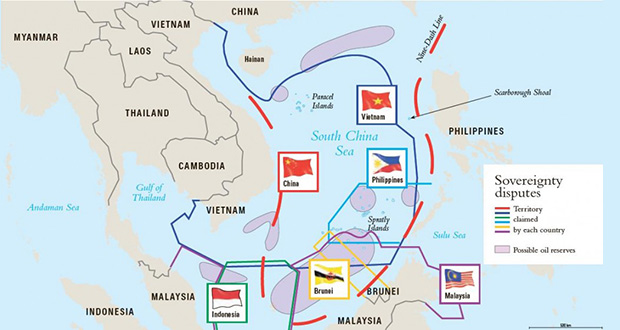During the last week of October, an already-elevated level of tension over the South China Sea cauldron was raised a couple of notches higher. On October 27, a U.S. guided missile destroyer, the USS Lassen, conducted a Freedom of Navigation operation in the waters abutting the China-built artificial islands on Subi Reef/Zhubi Jiao and Mischief Reef/Meiji Jiao. Two days later, a Tribunal constituted under the United Nations Convention on the Law of the Sea (UNCLOS) issued a highly-awaited Award on Jurisdiction and Admissibility in the South China Sea arbitration case featuring the Philippines and China. The interim award sets up a climactic final ruling in 2016.

The arbitration concerns an application by the Philippines on three inter-related matters – the source of maritime entitlements in the South China Sea and the standing of “historic rights” therein; the status of certain land features in these waters and the maritime entitlements they are capable of generating; and the lawfulness of certain Chinese land reclamation and law enforcement actions. Specifically, Manila seeks a ruling that none of the insular features in the South China Sea – be it the Scarborough Shoal/Huangyan Dao in the Northern Sector of the Sea or the Spratly/Nansha Islands in the Southern Sector, is capable of generating an entitlement to an exclusive economic zone (EEZ). They are ‘rocks’ at best which generate a territorial sea at most. Consequently, there are no overlapping entitlements in the South China Sea and Chinese land reclamation activities in the Southern Sector and law enforcement actions across both sectors have interfered with and violated Manila’s sovereign rights and freedoms in its EEZ. Finally, it seeks a ruling that the Nine Dash Line has no basis in the LOS Convention and under international law insofar that it purports to define the limits of China’s claim to “historic rights.”
Fifteen specific submissions for redress are laid out and Manila has even gone so far as to pay Beijing’s share of the costs of the arbitration to keep the wheels of justice moving swiftly. That 14 of 15 submissions were admitted (some with reservations) by the Tribunal in its jurisdiction-related award on October 29 should not be seen as a vindication however of the strength of Manila’s legal arguments. One significant victory and a few marginal rulings in its favor aside, Manila is likely to come up empty-handed for the most part in the final award.
The key driver of the Philippines’ legal filing in January 2013 was a jurisprudential innovation laid down by the International Court of Justice (ICJ) in November 2012. In Nicaragua v Colombia the ICJ had found that a small maritime feature – be it even defined as an “island” – situated on the ‘wrong side’ of the median line as well as many nautical miles (nm) removed from any such similar feature, tended to produce a cut-off effect that disproportionately disadvantaged an opposite state’s coastal projection-based maritime entitlement. It ruled that such a feature be enclaved in the course of delimiting the maritime boundary – providing in the process a celebrated victory for Nicaragua’s legal counsel who, not coincidentally thereafter, took up the cudgels on Manila’s behalf in the current arbitration.
In 2016, the Tribunal appears poised to sustain this ‘enclaving’ argument with regard to the Scarborough Shoal – a similarly isolated feature that resides deep within the Philippines’ coastal projection but is administered by China. Although Nicaragua v Colombiawas issued in the context of an overlapping maritime delimitation, the Philippines/China Tribunal added to the body of interpretation by observing that a dispute over claimed entitlements should not be automatically conflated with one concerning delimitation, and that the former was adjudicable in the rarer instances where an overlap in the claims is lacking. Scarborough Shoal, it noted, was more than 200 nm removed from any claimed feature in the South China Sea – as such it was excluded from Beijing’s Article 298 sea boundary delimitation-related opt-out and liable presumably therefore to be enclaved.
This action will in effect place the Northern Sector of the Sea adjacent to the metropolitan island of Luzon, including its exploitable hydrocarbon resources, beyond the zone of entitlement generated by the shoal and firmly within Manila’s exclusive jurisdictional reach. Beijing can still argue though that the overlapping entitlement from its claimed Nanshan Island in the northern-most Spratlys empowers it to exercise sovereign rights and jurisdiction to exploit a share of the vast Reed Bank hydrocarbon bounty.
Nicaragua v Colombia also foreshadows the limits to Manila’s legal entrepreneurialism. The ICJ, recalling that international law did not prescribe any minimum size which a land feature must possess in order to be considered an “island,” had accorded this status to a feature 0.7 meters above sea-level at high-tide. Following suit, the Philippines/China Tribunal will find that every Beijing-administered feature in the Spratlys group resides within a 200 nm radius of a Chinese-claimed “island” and, as a consequence of this overlap, is barred by China’s sea boundary delimitation-related opt-out from determining the entitlement of each of these features in the Southern Sector of the South China Sea. Let alone agree with Manila’s contention that no feature in the Spratlys warrants an entitlement beyond that of a “rock,” the Tribunal will be jurisdictionally precluded from arriving at a merits-based finding that Beijing’s land reclamation activities and law enforcement actions in this Southern Sector have violated Manila’s exclusive rights and freedoms. This Southern Sector will persist as a patchwork of competing jurisdiction.
As for the rash of artificial island-building by China, each instance – be it on a low-tide or high-tide elevation – is in any case blatantly legal, even though the Obama Administration deems the reclamations to be a disturbance of the status quo. As a coastal state, China has the exclusive right to construct such islands, installations and structures, and exercise jurisdiction thereof, so long as the feature atop which they are constructed resides within the EEZ generated by a Beijing-claimed “island” within the Spratlys (which they do).
Finally, on the third key matter – the legal validity, if any, of the Nine Dash Line as a “historic rights” line; its standing, if any, within the framework of the LOS Convention; and the effects of such rights, if any, on maritime delimitation, the Tribunal’s findings has the potential to astonish the dashed-line’s legion of detractors in Southeast Asian capitals and in the West.
Contrary to the legal analysis issued by the U.S. State Department in December 2014, there are indeed important elements that are capable of creating “historic rights” in maritime spaces beyond the narrow confines of the articles on historic bays and titles in the LOS Convention. So long as the historical access and enjoyment practices of traditional Chinese fishermen within the perimeter of the Nine Dash Line was ‘continuous, reasonable and certain’ and rises to being a local custom or tradition, these practices are not qualified by the Convention. They are instead governed by the rules of general and customary international law and – so long as they are exercised non-exclusively and are not backed by the long arm of Chinese enforcement in foreign EEZs – the South China Sea littoral states are obliged to pay due regard to these local custom-based “historic rights” of traditional Chinese fishermen in the exercise of sovereign rights and jurisdiction within each of their exclusive maritime zones created by the Convention.

China’s Nine-Dash Line
Beijing bears a prior obligation though to lay out a cognizable “historic rights” based claim to the waters within the perimeter of the Nine Dash Line and limit the scope of that assertion to practices that have been ‘continuous, reasonable and certain’. In an ironic twist, Manila too is claiming such local custom-based traditional fishing rights in the territorial sea of the Scarborough Shoal, and is likely to receive a favorable hearing.
Neither Beijing nor Manila will walk away dejected in 2016. The same cannot be said of Vietnam. The final ruling will confirm that each Chinese intervention and ‘incident’ over the past half-decade in what Hanoi has hitherto claimed to be its exclusive maritime zone is covered within Beijing’s jurisdictional opt-outs (and hence resolvable only via negotiations and consultations). If the Nine Dash Line is mainstreamed into international law, Hanoi will bear a correlative obligation to take Beijing into confidence when it frames regulations that impinge on the rights of traditional Chinese fishermen in its waters that overlap with the Nine Dash Line. Rather than lodge belligerent findings (unlike Kuala Lumpur) as an interested Third Party within the Tribunal’s setting, Hanoi should sit down bilaterally with Beijing and sort out its mutual differences on entitlements, obligations and jurisdiction in this contested waterway.

